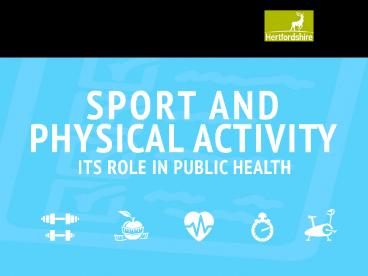Sport - PowerPoint PPT Presentation
Title: Sport
1
(No Transcript)
2
Sport Physical Activity Its Role in Public
Health.
- How participation in sport activity can reduce
alcohol intake assist with smoking cessation - Facilitators
- Gemma Foley
- Mark Bennett
3
Who are we? and what do we do?
- Mark Bennett - Reparation officer for
Hertfordshire Youth Justice. Qualified Rugby
Coach, Qualified Boxercise Instructor. - Gemma Foley Forensic Adolescent Practitioner,
Camhs worker for Hertfordshire Youth Justice.
Qualified Level 2 Exercise to Music Instructor.
4
Why Run a Health and Well Being Group for Young
Offenders in Herts?
5
Identifying a need
- Asset (assessment tool used in Youth Justice)
identified high areas of need and risk under the
following areas - Drugs and alcohol high rates of alcohol, drug
use and smoking tobacco amongst young offenders
in Hertfordshire Area of Watford and Three
Rivers - Physical health high proportion of young
offenders smoking tobacco. - Emotional and Mental Health - High rates of
emotional, behavioural and mental health
difficulties.
6
Reasons to carry out a health and well being group
- Facilitators have skills, qualifications and a
specialist interest in the area of sport and
exercise. - It was felt that a more practical approach to
health promotion would improve levels of
engagement and positive outcomes for long term
change in this client group. - Lots of research highlighting benefits of
exercise for both physical and emotional
wellbeing.
7
Research Evidence
- The Joseph Rowntree Foundation Report dated 17th
June 2011. Study involved 5,700 Teenagers. - Young people are more likely to drink alcohol if
they have little positive activity in their
lives - physical activity made young people more self
aware, proud of there physical health, take
responsibility for their health and built their
self confidence and body image. This made it less
likely for them to engage in binge drinking
behaviour
8
Research Evidence
- The Guardian Newspaper (2008) Study by Positive
Futures Project. - almost half of teenagers questioned in the study
said they thought more sports and leisure
activities were the way to divert young people
from alcohol - Psychology of Sport Exercise May (2009) Vol 10
(3) 381-389 - Children who spent time in sports had higher
self esteem scores then those who did not. In
summary Exercise is a means to promote self worth
other important physical self perceptions like
body image
9
Aims of the Group
- To Educate and inform the group members of the
long term and short term health implications of
using alcohol and drugs (inclusive of smoking
Tobacco) - To highlight the benefits of exercise on both
physical and mental wellbeing and provide group
members with opportunities to experience
engagement in some form of physical activity. - To encourage young people to consider using
exercise as a coping strategy to manage stress
rather then using other maladaptive strategies ie
alcohol, drugs and smoking. - Overall Aim To increase Young peoples awareness
about how to improve and maintain there health
and well being.
10
Structure of the group
- Client group YOT cases (male only) Pilot Group
- Age 14-17
- Duration 2.5 hours
- Location Community resources in Watford and
Three Rivers District.
- Session 1 - Introduction to group / Aims and
rules of the group. Circuits - Session 2 - Smoking cessation. Badminton/Table
Tennis. - Session 3 - Drugs and alcohol. Boxing.
- Session 4- Nutrition. Football
- Session 5 Benefits of exercise on Physical and
Emotional Health. Circuits
11
Use of the Rosenberg Self esteem Scale
(Rosenberg, 1965)
- Used to assess participants levels of self esteem
pre and post exercise. - Tool used for every session with each participant
to ascertain longer term gains and to encourage
them to reflect on how they feel following
engagement in physical activity.
12
Self Esteem Outcome Measures
13
Self Esteem Outcome Measures
14
Self Esteem Outcome Measures
15
Other Interventions used alongside Exercise
- Discussions Debates
- Space to Reflect
- Use of monitoring Systems Re Self esteem, BP
Pulse. - Quiz
- Obstacle course using beer goggles.
- Drug box
- Tar jar and phlegm jar
- Money and health wheels
16
Positive Statements!!!
- Here are some statements made by young people
that indicate contemplation to change!.
I might join the boxing club again
I could save how much?
Can cannabis really effect your sperm count!!!!
Smoking makes your fingers go yellow!
I am not as fit as I thought!!
17
Analysis of Graphs/ Future Questions?
- Is there a significant difference in the impact
of exercise on self esteem depending on
intensity? - Is there a difference between the impact of
exercise on self esteem depending on duration of
activity?
18
Development of Group.
- To progress group across the county.
- To utilise group across both Genders ( Pilot only
used with Male clients). - To continue collecting Evidence using Rosenberg
Self Esteem Questionnaire and other outcome
measure tools i.e. carbon dioxide measures, BP
and pulse readings. - Opportunity to gain AQA Qualifications
19
Future Considerations/ Potential Limitations
- How to implement longer term use of exercise
after group is finished? - Affordability
- Accessibility of services
- Sustainability (Motivation to maintain by the
young people)
20
Questions!!!!
21
(No Transcript)































